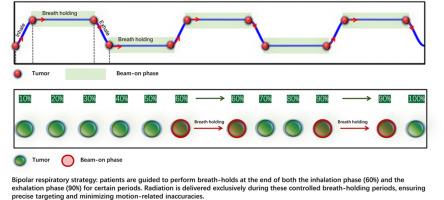Developing and validating a bi-polar gated respiratory motion management strategy for improved lung stereotactic body radiotherapy treatment
IF 2.8
引用次数: 0
Abstract
Background
Stereotactic body radiotherapy (SBRT) is an effective treatment for early-stage non-small cell lung cancer. However, patient breathing can affect treatment accuracy. Therefore, this study aimed to develop a bi-polar (BP) gated motion management strategy for SBRT and evaluate its feasibility geometrically and dosimetrically.
Methods
The BP strategy involved instructing patients to hold their breath briefly at the end of both inhalation (EI) and exhalation (EE), with radiation delivered only during these breath-holding periods. Eight volunteers were included to evaluate breathing stability, repeatability, and patient comfort. Additionally, 15 patients were retrospectively studied to evaluate the geometric and dosimetric efficiency of BP in intensity-modulated radiation therapy (IMRT) and volumetric modulated arc therapy (VMAT) modes. BP plans were compared with four common breathing strategies: free breathing (FB), gating at the end of inhalation (GI), gating at the end of exhalation (GE), and real-time tracking (RT).
Results
Volunteers could comfortably hold their breath for >3 minutes, demonstrating good stability and repeatability. Geometrically, the ratio of BP's internal target volume (ITV) to GI's ITV was the smallest at 0.65, compared to 1.89 for FB, 1.05 for GE, and 0.68 for RT. In the dosimetric evaluation of IMRT plans, the lung V20Gy ratio for BP to GI was the smallest at 0.89. Similar trends were observed for VMAT plans.
Conclusions
The BP strategy is a feasible option for lung SBRT, offering reduced treatment volumes and normal tissue toxicity, with a high duty cycle and less technical complexity than other RT-based methods.

发展和验证双极门控呼吸运动管理策略,以改善肺立体定向放射治疗
背景立体定向放射治疗(SBRT)是早期非小细胞肺癌的有效治疗方法。然而,病人的呼吸会影响治疗的准确性。因此,本研究旨在开发一种双极性(BP)门控运动管理策略,并从几何和剂量学角度评估其可行性。方法BP策略包括指导患者在吸气(EI)和呼气(EE)结束时短暂屏气,仅在屏气期间进行放射治疗。8名志愿者被纳入评估呼吸稳定性、可重复性和患者舒适度。此外,对15例患者进行回顾性研究,以评估调强放疗(IMRT)和体积调制弧线治疗(VMAT)模式下BP的几何和剂量学效率。将BP计划与四种常见的呼吸策略进行比较:自由呼吸(FB)、吸入末门控(GI)、呼气末门控(GE)和实时跟踪(RT)。结果受试者能舒适地憋气3分钟,稳定性和可重复性好。从几何上看,BP的内部靶体积(ITV)与GI的ITV之比最小,为0.65,而FB为1.89,GE为1.05,rt为0.68。在IMRT计划的剂量学评估中,BP与GI的肺V20Gy之比最小,为0.89。VMAT计划也观察到类似的趋势。结论BP策略是肺SBRT的一种可行选择,与其他基于rt的方法相比,BP策略具有治疗量小、组织毒性正常、占空比高、技术复杂性低的优点。
本文章由计算机程序翻译,如有差异,请以英文原文为准。
求助全文
约1分钟内获得全文
求助全文
来源期刊

Cancer pathogenesis and therapy
Surgery, Radiology and Imaging, Cancer Research, Oncology
CiteScore
0.80
自引率
0.00%
发文量
0
审稿时长
54 days
 求助内容:
求助内容: 应助结果提醒方式:
应助结果提醒方式:


